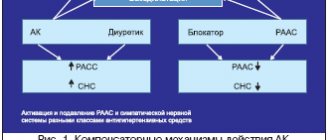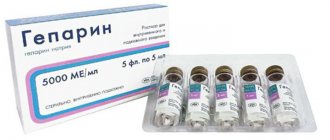Anticoagulant therapy is a set of therapeutic measures aimed at inhibiting blood clotting activity and preventing the formation of blood clots. The use of anticoagulants makes it possible to have a targeted effect on different parts of the blood coagulation process. This makes it possible to use them in a number of serious pathological conditions.
CELT phlebologists are well acquainted with the principles of anticoagulant therapy and have been successfully applying them in practice for several years. They carry out an individual selection of appropriate drugs, preventing the development of such dangerous conditions as thrombosis and blockage of blood vessels. Their efforts reduce the risk of heart attacks and strokes.
Our doctors
Drozdov Sergey Alexandrovich
Cardiovascular surgeon, phlebologist, Doctor of Medical Sciences
47 years of experience
Make an appointment
Malakhov Yuri Stanislavovich
Doctor - cardiovascular surgeon, phlebologist, Honored Doctor of the Russian Federation, Doctor of Medical Sciences, doctor of the highest category
Experience 36 years
Make an appointment
Indications and contraindications for anticoagulant therapy
Anticoagulants are substances that inhibit blood clotting activity. They have a wide spectrum of action, minimizing exacerbations of diseases of the cardiovascular system in the form of strokes and heart attacks. By starting treatment with anticoagulants in a timely manner, it is possible to prevent the formation of blood clots in blood vessels with their subsequent blockage and the development of a number of serious complications.
Usually blood clots are tightly fixed to the walls of blood veins, but under the influence of blood flow, elevated temperature, blood pressure or physical stress they can come off. This situation arises suddenly, and a person’s life in it depends on how correctly and quickly medical care is provided to him. The consequences can be the most tragic: from stroke and heart attack to pulmonary embolism and thrombosis of the leg veins. Correct use of anticoagulants can eliminate these complications.
| Indications for anticoagulant therapy: | Contraindications to the use of anticoagulants: |
| Taking anticoagulants is not recommended for pregnant women, as it can cause disturbances in the embryonic development of the fetus and bleeding during the gestational period. It is also not recommended for patients suffering from:
|
As part of the second congress of the Eurasian Arrhythmological Association and the eighth congress of cardiologists, cardiac surgeons and x-ray endovascular surgeons of the Republic of Belarus, a symposium “Complex cases in cardiology” was held. Experts focused on antithrombotic treatment and its complications in patients with atrial fibrillation who have had a stroke.
Global Burden
Natalya Koziolova, Doctor of Medicine. Sciences, ProfessorHead of the Department of Propaedeutics of Internal Diseases No. 2, Perm State Medical University named after. Academician E. A. Wagner (Russia), member of the presidium of the board of the Russian Society of Cardiology, President of the Perm Regional Cardiological Society, Doctor of Medicine. Sciences, Professor Natalya Koziolova shared new data on secondary prevention of stroke in patients with atrial fibrillation (AF).
First of all, Natalya Andreevna drew attention to the urgency of the problem. Thus, according to research, in 2019 alone, 12.2 million strokes were diagnosed in 204 countries: 7.63 million ischemic strokes, 3.41 million cerebral hemorrhages, 1.18 million subarachnoid hemorrhages. Over 29 years, as a result of this pathology, 143 million people became disabled. In the structure of causes of disability, both in 1990 and in 2019, strokes took second place.
Natalya Koziolova:
It is worth noting that the frequency of pathology is increasing among people aged 18–50 years. There are 2 million such patients per year in the world, and this number is increasing. However, knowledge about the global distribution of risk factors and etiology, as well as information about prognosis and optimal secondary prevention in young patients, is insufficient. This limits evidence-based treatment and prevents the provision of relevant information about stroke causes, risk factors and prognosis.
Traditionally, according to the expert, ischemic strokes, as well as intracranial and subarachnoid hemorrhages, lead to death. In Russia in 2015, more than 300 thousand ischemic strokes and more than 66 thousand hemorrhagic strokes were registered. Among ischemic strokes, the leading one is atherothrombotic, every fifth is cardioembolic.
Natalya Koziolova:
Enormous efforts are invested in the treatment of patients with cerebral catastrophes, and not only medical ones. A federal project is being implemented in Russia: for 2 years, patients after a stroke are given free medications, including the best and most expensive direct oral anticoagulants. The patient is required first of all to be committed to treatment. Morbidity and mortality are decreasing slightly, but still, according to one of the statistical databases in 2021, Russia ranked first in the world in terms of mortality from stroke.
In the USA, for example, huge amounts of money are also spent on treating patients with stroke. However, since 2013, there has been a negative trend towards an increase in mortality from this pathology, regardless of age. By the way, in the United States, every 20th patient in the age category 60–79 years has suffered a stroke.
Natalya Koziolova:
According to studies, if a 60-year-old patient follows recommendations for stroke prevention, he will survive 20 years. In case of a stroke, survival time is reduced to 8 years.
The incidence of recurrent stroke in Russia (according to the National Stroke Registry), according to the expert, is huge - 0.79 per thousand population. The share of ischemic among recurrent strokes is 87.5%, of unspecified etiology - 4.6%. The prevalence rate of recurrent stroke among all strokes is 25.5%. Every 5th patient in Russia has a recurrent stroke.
Natalya Koziolova:
For a long time it was believed that the most dangerous period after a stroke was the first month and first year. Unfortunately, the latest data suggests that in fact, 1 in 5 people will die within 4 years of having a second stroke. In the 3rd–5th year, patients calm down and adherence to treatment is impaired.
Error Analysis
Natalya Koziolova:
In the presence of AF, the risk of cardioembolic stroke increases almost 16 times. Therefore, patients with AF should be treated with great care, especially if they have already suffered a stroke.
An expert analyzes a case from practice. A 67-year-old woman consulted a therapist with complaints of fatigue, weakness, insomnia, and recurrent headaches. Eight months ago she suffered an ischemic stroke in the right hemisphere. She has had a persistent form of AF for four years (8–19 paroxysms per year), as well as hyperlipidemia (a risk factor for recurrent stroke) for 7 years (LDL cholesterol - 3.1 mmol/l with a target level of less than 1.4 mmol/l ).
Natalya Koziolova:
Let's analyze the errors. The patient takes atorvastatin only 20 mg per day. In this case, we can talk about medical inertia: the specialist prescribed atorvastatin and stopped there,” Natalya Koziolova points out. “In addition, the patient has had hypertension for 10 years without achieving the target blood pressure level. She came to the appointment with a blood pressure of 160/95 mm Hg. Art. Question for the doctor who prescribed perindopril 10 mg per day and indapamide 1.5 mg per day and again stopped there.
The patient also has type 2 diabetes for 4 years. Taking into account age and previous stroke, the target glycated hemoglobin is 7.5% (takes dapagliflozin 10 mg per day). What does the patient gain from antithrombotic therapy? Only aspirin 100 mg per day, but continues to take (8 months) 2 more cerebroprotectors. What does the American recommendations say about this?
Today, pharmacological or non-pharmacological treatment using neuroprotective agents is not recommended: there is no evidence base for improving quality of life and prognosis. According to the CHA2DS2-VAС scale, the patient’s risk of stroke is very high – 6 points. The risk of hospitalization and death due to thromboembolic complications increases 20 times within a year! In this case, only aspirin was prescribed. The risk of bleeding on the HAS-BLED scale is 4 points (high).
Additionally, non-modifiable risk factors are taken into account. In the case of this patient, these are age, a history of ischemic stroke, and type 2 diabetes. Potentially modifiable risk factors include impaired renal function; modifiable risk factors include arterial hypertension, the risk of thrombosis and bleeding.
Natalya Koziolova:
We can correct two factors: we can treat hypertension and stop aspirin. There is still a high risk of bleeding and a very high risk of recurrent stroke. What to prescribe in this case? Of course, anticoagulants (ACs), with the new oral anticoagulants (NOACs) now being preferred over vitamin K antagonists (VKAs)—except in patients with mechanical heart valves or moderate-to-severe mitral valve stenosis.
European recommendations state that antiplatelet agents (not just aspirin, but any) in monotherapy or in combination with clopidogrel are not recommended for the prevention of stroke in patients with AF - the risk of bleeding increases, but the risk of stroke does not decrease.
Indications and choice of oral anticoagulants (OAC) for AF:
- OACs are recommended for the prevention of stroke in patients with results on the CHA2DS2-VAS scale of 2 or more points in men, 3 or more points in women.
- If the risk of stroke is assessed as low (on the CHA2DS2-VAS scale 0 points in men, 1 point in women), antithrombotic therapy is not recommended.
- OAC should be considered for stroke prevention in patients with AF with a CHA2DS2-VAS score of 1 in men and 2 in women.
- Treatment should be individualized based on pure clinical benefit and taking into account patient benefits and preferences.
According to the updated 2021 European Society of Cardiology (ESC) guidelines, in patients with AF and ischemic stroke or transient ischemic attack (TIA), long-term secondary stroke prevention with OACs is recommended in the absence of absolute contraindications, with NOACs being preferred over VKAs in patients , which are suitable for PLA.
In patients with AF and acute ischemic stroke, early anticoagulation (<48 hours) with low molecular weight heparins (LMWH), unfractionated heparin, or VKAs is not recommended. This is a risk factor for early hemorrhagic transformation.
Natalya Koziolova:
Why NOACs and not VKAs (warfarin) in patients with AF after ischemic stroke or TIA? A meta-analysis of 4 randomized clinical trials showed that NOACs, compared with warfarin, statistically significantly reduce recurrent strokes and systemic embolisms by 13.7%, hemorrhagic strokes by 50%, any strokes by 13.1%, intracranial hemorrhages by 46.1%, - explains Natalya Koziolova.
The expert notes that nothing has changed in the American recommendations since 2014. The European drug rivaroxaban is preferred. According to studies, rivaroxaban compared with warfarin reduced the risk of recurrent stroke by a statistically significant 52% without increasing the risk of major bleeding, with a clinical benefit of 55%.
The combination of OACs (warfarin, NOACs) with antiplatelet agents is not recommended after ischemic stroke or TIA.
For patients with AF who have had an ischemic stroke or TIA and who cannot take OACs, aspirin or a combination of aspirin and clopidogrel is recommended.
Natalya Koziolova:
What should not be done when we talk about preventing a recurrent stroke, especially in the first month? Warfarin should not be prescribed, since in the first month the risk of recurrent ischemic events increases by 71%. Warfarin doesn't work yet. In addition, it has been proven that warfarin in patients with AF increases the risk of all types of dementia, because it causes vitamin K deficiency, which increases the risk of calcification and increases the risk of vascular accidents.
Antithrombotic therapy and intracranial hemorrhage
Natalya Mitkovskaya, Director of the Republican Scientific and Practical Center "Cardiology", Head of the Department of Cardiology and Internal Diseases of the Belarusian State Medical University, Doctor of Medicine. Sciences, professor. Director of the Republican Scientific and Practical Center “Cardiology”, head of the Department of Cardiology and Internal Diseases of the Belarusian State Medical University, chief freelance specialist in cardiology of the Ministry of Health, Doctor of Medicine. Sciences, Professor Natalya Mitkovskaya drew attention to the risk factors for bleeding in a patient with AF during antithrombotic therapy.
Natalya Mitkovskaya:
Any cerebral infarction is accompanied by a certain percentage of hemorrhages, and our ability to successfully navigate between the risks of cerebral infarction and intracranial hemorrhage determines the patient’s chances of survival.
The CHA2DS2-VAСс and HAS-BLED scales should be on the desktop, mobile phone, computer of every general practitioner, therapist and cardiologist. Indeed, new oral anticoagulants occupy a leading position in the prevention of cerebral infarction in patients with AF, and they must be prescribed taking into account the indications, the risk of bleeding, and not forgetting to monitor the functional state of the kidneys and other organs. However, more than half of patients after cerebral infarction do not receive OAC, 50% of them are over 80 years of age.
Natalya Mitkovskaya draws attention to the importance of monitoring and correcting risk factors for bleeding (according to the 2020 ESC recommendations) ( see table ).
Table. Risk factors for bleeding
The 2021 American Heart Association/American Stroke Association (AHA/ASA) guidelines state that in patients who are eligible for alteplase treatment for stroke, the benefit is time dependent: treatment should be initiated as early as possible.
- Intravenous alteplase (0.9 mg/kg, maximum dose 90 mg over 60 minutes with an initial bolus of 10% of the dose over 1 minute) is recommended for patients who are admitted for treatment within 3 hours of the onset of ischemic symptoms. stroke or since the last time asymptomatic (IA) was established.
- Administration of alteplase is also recommended for patients presenting for treatment within 3 and 4.5 hours of the onset of ischemic stroke symptoms or the last time symptom-free was established (I BR—moderate-quality evidence from one or more RCTs) ).
Natalya Mitkovskaya:
It is fundamentally important to note in the medical documentation when the primary medical contact between the doctor and the patient took place, when an ECG or other study was performed, and when the administration of the drug began. The time interval is the patient's life.
- Administration of alteplase for 4.5 hours is also recommended for patients who awaken with stroke symptoms or have an unclear onset time >4.5 hours from the onset of stroke symptoms or the last time asymptomatic, when the lesion is less than one third detected on MRI zones of vascularization of the middle cerebral artery and the absence of visible signal changes in FLAIR mode.
- For small intracranial hemorrhage (1–10 mL) on MRI, alteplase (IIA BR) may be considered.
- In patients eligible for thrombolytic therapy who have cerebral hemorrhage (>10 mL) confirmed by MRI, alteplase may be associated with an increased risk of recurrent clinically significant hemorrhage, and the benefit of treatment has not been determined. The use of alteplase may be justified if there is potential for significant benefit.
- Intravenous aspirin should not be administered within 90 minutes of the initial use of alteplase. The ARTIS study found that intravenous aspirin use was associated with an increased risk of clinically significant intracranial hemorrhage.
- But the use of aspirin orally is recommended in patients with cerebral infarction 24–48 hours after its development. When using alteplase, administration of aspirin 24 hours after the event is appropriate, but the approach must be individualized with careful assessment of comorbid conditions, benefits and risks.
- Alteplase should not be administered to patients who have received a treatment dose of low molecular weight heparin within the previous 24 hours.
- Blood pressure should be maintained at <180/105 mmHg. Art. at least 24 hours after the start of intravenous alteplase administration.
- The risk of antithrombotic therapy (other than intravenous aspirin) during the first 24 hours after administration of alteplase (with or without mechanical thrombectomy) should be considered individually in the presence of concomitant conditions for which such treatment, given in the absence of intravenous alteplase, would provide significant benefit, and failure would cause significant risk.
- In the case of a high risk of hemorrhagic complications (large cerebral infarction, hemorrhagic leakage on initial neuroimaging, uncontrolled hypertension or tendency to hemorrhage), it is advisable to delay the initiation of oral anticoagulant therapy beyond 12-14 days from the onset of stroke (see Fig. 1).
Figure 1. Tactics for initiating anticoagulant therapy for AF and ischemic stroke
- The strategy for restarting anticoagulant therapy in patients with AF after intracranial hemorrhage depends on the individual characteristics of the patient.
- Consideration of risk factors for recurrent intracranial hemorrhage is recommended.
- Elimination of modifiable risk factors.
- Assessing the risk/benefit ratio of restarting oral anticoagulants.
- Resumption of anticoagulant therapy in patients with AF following intracranial hemorrhage should be carried out in accordance with ESC recommendations 4–8 weeks after the complication, selecting the drug with the lowest risk of recurrent hemorrhage.
- The patient, after resuming anticoagulant therapy, needs careful clinical and laboratory monitoring.
- How to organize monitoring of a patient taking OAC, especially if there is a high risk of bleeding, see Fig. 2.
Figure 2. Monitoring a patient taking OAC if there is a high risk of bleeding
Types of anticoagulants
Depending on the mechanism of action, it is customary to distinguish two types of anticoagulants: direct and indirect effects. The former reduce the activity of the thrombin enzyme, the latter increase the production of prothrombin. It is worth noting that anticoagulants of indirect action have a number of disadvantages that are absent in analogs of direct action. This determines the popularity of the latter, although they became available for treatment relatively recently: about ten years ago.
| Direct anticoagulants | Anticoagulants of indirect action |
The use of direct anticoagulants has a number of advantages:
Direct anticoagulants are represented by products containing heparin and hirudin. They are available as solutions for intramuscular and intravenous administration, ointments and gels | The use of indirect anticoagulants is based on the accumulation effect, which provokes an increase in the production of prothrombin. It can last from four to fourteen days. Indirect anticoagulants are used to prevent thromboembolism. They are available in the form of capsules and tablets (for example: Warfarin, Phenilin, others). Their disadvantages are as follows:
|
Complications of anticoagulant therapy
Taking anticoagulants is associated with a number of complications. They can be excluded if you strictly follow the instructions of the treating phlebologist, follow the dose and regularly monitor blood coagulation function. When anticoagulants are administered by injection, a hematoma may appear in the injection area. This phenomenon occurs due to the dilution of blood in the blood capillaries and its leakage through the vascular walls.
While taking anticoagulants, the patient needs to be especially attentive to his condition and contact his doctor if the following clinical manifestations appear:
- Painful symptoms affecting the lumbar region;
- Feeling of weakness and numbness in the legs;
- Recurrent pain and discomfort in the upper abdomen;
- Any disturbances in the functioning of the genitourinary system;
- Regular sudden hemorrhages.
If you want to be sure that treatment with anticoagulants will give the desired result and go without complications, contact the specialists of the phlebology department of CELT. You can make an appointment with them online or by contacting our operators.
Make an appointment through the application or by calling +7 +7 We work every day:
- Monday—Friday: 8.00—20.00
- Saturday: 8.00–18.00
- Sunday is a day off
The nearest metro and MCC stations to the clinic:
- Highway of Enthusiasts or Perovo
- Partisan
- Enthusiast Highway
Driving directions
Related medical procedures
Before any medical procedure, be sure to inform your doctor that you are taking anticoagulants and strictly follow his recommendations. On the eve of the procedure, monitoring the level of blood clotting is mandatory. For some dental procedures (filling, canal cleaning, removal of tartar, installation of crowns and bridges), if clotting is within the individual corridor, a change in the therapy regimen is not required. Before tooth extraction, a slight reduction in the dose of the drug taken may be required.
It must also be remembered that patients with a prosthetic heart valve require infection prevention
(bacterial endocarditis).
For this purpose, antibiotics are recommended before and after invasive intervention. This is necessary before visiting the dentist, any urological procedure, gynecological intervention, colon examination, tonsillectomy or implantation of any medical device. Back to section








